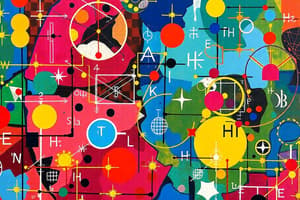Podcast
Questions and Answers
Which of the following correctly describes complex numbers?
Which of the following correctly describes complex numbers?
- Numbers that only include whole numbers.
- Numbers that can be represented as fractions.
- Numbers that have a real part and an imaginary part. (correct)
- Numbers that can be plotted on a number line.
What is the slope-intercept form of a linear equation?
What is the slope-intercept form of a linear equation?
- y = mx^2 + b
- y = mx + c
- y = mx + b (correct)
- y = a + bx
Which units are used to measure volume?
Which units are used to measure volume?
- Square meters and square feet
- Meters and inches
- Liters and gallons (correct)
- Seconds and hours
What is the first step in effective problem-solving strategies?
What is the first step in effective problem-solving strategies?
Which of the following is NOT a type of graph?
Which of the following is NOT a type of graph?
What is included in the category of real numbers?
What is included in the category of real numbers?
What is the primary focus of trigonometry?
What is the primary focus of trigonometry?
Which theorem states that every non-constant polynomial equation has at least one complex root?
Which theorem states that every non-constant polynomial equation has at least one complex root?
In order of operations, which does PEMDAS/BODMAS prioritize first?
In order of operations, which does PEMDAS/BODMAS prioritize first?
Which branch of mathematics mainly involves the study of shapes, sizes, and properties of space?
Which branch of mathematics mainly involves the study of shapes, sizes, and properties of space?
Which concept in mathematics deals with collections of distinct objects?
Which concept in mathematics deals with collections of distinct objects?
What does the Mean Value Theorem imply about a function on a closed interval?
What does the Mean Value Theorem imply about a function on a closed interval?
Which of the following types of numbers can be involved in the operations of fractions?
Which of the following types of numbers can be involved in the operations of fractions?
Which type of function assigns to each element of a set exactly one element of another set?
Which type of function assigns to each element of a set exactly one element of another set?
Flashcards are hidden until you start studying
Study Notes
Key Concepts in Mathematics
1. Branches of Mathematics
- Arithmetic: Basic operations (addition, subtraction, multiplication, division).
- Algebra: Involves symbols and letters to represent numbers and quantities in formulas and equations.
- Geometry: Study of shapes, sizes, and properties of space; includes points, lines, angles, surfaces, and solids.
- Trigonometry: Focuses on the relationships between the angles and sides of triangles.
- Calculus: Involves limits, derivatives, integrals, and infinite series; studies change and motion.
- Statistics: Collection, analysis, interpretation, presentation, and organization of data.
2. Fundamental Theorems
- Pythagorean Theorem: In a right triangle, the square of the hypotenuse is equal to the sum of the squares of the other two sides.
- Fundamental Theorem of Algebra: Every non-constant polynomial equation has at least one complex root.
- Mean Value Theorem: A function that is continuous on a closed interval and differentiable on the open interval has at least one point at which the derivative equals the average rate of change.
3. Important Mathematical Concepts
- Set Theory: Studies collections of objects, called sets; includes concepts of union, intersection, and subsets.
- Functions: A relation that assigns to each element of a set exactly one element of another set; types include linear, quadratic, polynomial, and exponential.
- Probability: Measures the likelihood of an event occurring; includes concepts of independent and dependent events.
4. Mathematical Operations
- Order of Operations: PEMDAS/BODMAS (Parentheses/Brackets, Exponents/Orders, Multiplication and Division, Addition and Subtraction).
- Fractions: Division of numbers; includes simplification, addition, subtraction, multiplication, and division of fractions.
- Decimals: Representation of numbers in base ten; involves operations similar to whole numbers.
5. Measurement and Number Systems
- Real Numbers: All numbers on the number line, including rational and irrational numbers.
- Complex Numbers: Numbers that have a real part and an imaginary part (e.g., a + bi).
- Units of Measurement: Length (meters, inches), area (square meters, square feet), volume (liters, gallons), and time (seconds, hours).
6. Graphing and Visualization
- Coordinate System: A two-dimensional plane defined by an x-axis and a y-axis.
- Graph Types: Includes line graphs, bar charts, histograms, and pie charts.
- Slope-Intercept Form: A linear equation of the form y = mx + b, where m is the slope and b is the y-intercept.
7. Problem-solving Strategies
- Understanding the Problem: Read carefully and identify knowns and unknowns.
- Devising a Plan: Choose appropriate strategies (diagram, equations, etc.).
- Carrying Out the Plan: Execute the chosen methods step-by-step.
- Reviewing/Checking: Verify the solution to ensure accuracy.
Conclusion
Mathematics is a vast field with numerous branches and applications. Understanding fundamental concepts and theorems is essential for problem-solving and advanced study within the discipline.
Branches of Mathematics
- Arithmetic: Involves basic operations such as addition, subtraction, multiplication, and division.
- Algebra: Uses symbols and letters to represent numbers in formulas and equations, facilitating the solving of problems.
- Geometry: Examines shapes, sizes, and spatial properties, including points, lines, angles, surfaces, and solids.
- Trigonometry: Investigates relationships between the angles and sides of triangles, crucial for various applications in science and engineering.
- Calculus: Studies change and motion through concepts such as limits, derivatives, integrals, and infinite series, essential for advanced mathematics.
- Statistics: Focuses on data collection, analysis, interpretation, presentation, and organization, aiding in decision-making processes.
Fundamental Theorems
- Pythagorean Theorem: States that in a right triangle, the square of the length of the hypotenuse equals the sum of the squares of the lengths of the other two sides.
- Fundamental Theorem of Algebra: Asserts that every non-constant polynomial equation has at least one complex root, linking algebra to complex number theory.
- Mean Value Theorem: Indicates that for a continuous function on a closed interval that is differentiable on the open interval, there is at least one point where the derivative equals the average rate of change.
Important Mathematical Concepts
- Set Theory: Analyzes collections of objects, with core operations such as union, intersection, and identification of subsets.
- Functions: Defines relationships that pair each element of one set to exactly one element of another; include various types such as linear, quadratic, and exponential functions.
- Probability: Evaluates the likelihood of events, distinguishing between independent and dependent events for accurate predictions.
Mathematical Operations
- Order of Operations: Follows the PEMDAS/BODMAS rule to determine the sequence for performing operations: Parentheses/Brackets, Exponents/Orders, Multiplication and Division, Addition and Subtraction.
- Fractions: Represents division and requires skills in simplification, as well as addition, subtraction, multiplication, and division among fractions.
- Decimals: Works with base ten representations of numbers, encompassing operations similar to those with whole numbers.
Measurement and Number Systems
- Real Numbers: Includes all numbers found on the number line, comprising both rational (fractions) and irrational (non-repeating, non-terminating decimals).
- Complex Numbers: Comprises numbers with a real part and an imaginary part, denoted as a + bi, where i represents the square root of -1.
- Units of Measurement: Covers various dimensions such as length (meters, inches), area (square meters, square feet), volume (liters, gallons), and time (seconds, hours).
Graphing and Visualization
- Coordinate System: Establishes a two-dimensional plane defined by the x-axis (horizontal) and y-axis (vertical) for plotting points and graphs.
- Graph Types: Encompasses various graphical representations such as line graphs, bar charts, histograms, and pie charts for data visualization.
- Slope-Intercept Form: Represents linear equations in the format y = mx + b, where m is the slope and b is the y-intercept, simplifying the identification of linear relationships.
Problem-solving Strategies
- Understanding the Problem: Emphasizes careful reading to identify knowns and unknowns before attempting a solution.
- Devising a Plan: Involves selecting suitable strategies such as diagrams or equations to facilitate solving the problem.
- Carrying Out the Plan: Focuses on methodically executing chosen strategies step-by-step to arrive at a solution.
- Reviewing/Checking: Highlights the importance of verifying the solution to ensure accuracy and correctness before finalizing the answer.
Conclusion
- Mathematics encompasses a wide range of branches and applications, requiring comprehension of fundamental concepts and theorems for effective problem-solving and advanced study.
Studying That Suits You
Use AI to generate personalized quizzes and flashcards to suit your learning preferences.




